Wed 30 Dec 2015
JONATHAN LEWIS: Music I’m Listening To — FRANKIE LAINE “Blazing Saddles.”
Posted by Steve under Music I'm Listening To[8] Comments
Wed 30 Dec 2015
Tue 29 Dec 2015
RANDY WAYNE WHITE – The Heat Islands. St. Martin’s, hardcover, 1992; paperback, February 1993.
I’d been unaware of White’s books until the ladies at The Mystery Bookstore here very kindly loaned me the advance proofs of the current offering. The first in the series, Sanibel Flats, evidently didn’t make it to my local library branch, and I somehow missed seeing it reviewed.
Ford is a marine biologist with his own small biological supply company, operated out of a stilt house on Sanibel Island, Florida, that is both home and laboratory. All told, it’s the laid-back good life.
As we begin, the most hated man on the barrier islands is found floating face down in Dinkin‘s Bay. He was the owner/operator of the local marina, and had alienated enough people that suspects were in plentiful supply. One of Doc’s friends, a fishing guide, quickly becomes the prime suspect, but Doc doesn’t believe it, and begins his own investigation. An oddball relationship with a lady tennis pro enlivens things somewhat.
You know, I just can’t think of a whole lot to say about this one. I enjoyed reading it, in a mild sort of way; White writes adequately enough; Old Doc is a decent enough leading man; there really wasn’t anything to gripe about, so why aren’t I more positive? I don’t know, but I’m not.
Good enough for checking out of the library, but I’m glad I didn’t buy it.
Tue 29 Dec 2015
Mon 28 Dec 2015
IAN ALEXANDER – The Disappearance of Archibald Forsyth. Hutchinson & Co., UK, no date stated [1933].
Back in the printed version of Mystery*File, issue #46, one of the items in Al Hubin’s “Addenda to Crime Fiction IV†columns revealed that Ian Alexander was a previously unknown pen name of Alexander Knox.
In the very same issue, and totally unconnected with the Hubin entry, Charlie Shibuk mentioned Alexander Knox as one of the actors who appeared in Andre DeToth’s film None Shall Escape. This very remarkable coincidence went unnoticed by me, but naturally Charlie spotted it right away. He added the following information, which appeared in the letter column of M*F 47: “Knox was born in Canada in 1907 and appeared on stage and screen in England and America. He portrayed the title role in Wilson (1944).â€
Not only that, but he was nominated for an Oscar for his performance in that film.
As for his crime-writing career, this book at hand is the only one Knox wrote as Ian Alexander. In the 70s he wrote two novels included in Hubin’s Crime Fiction IV, both historical adventure novels based on the Canadian wilderness of the late 18th century. As Leonard Blackledge, he wrote one crime novel entitled Behind the Evidence (Hutchinson, 1935), and as John Crozier, he wrote two others: Murder in Public (Hutchinson, 1934) and Kidnapped Again (Hutchinson, 1935)
Both of the latter two novels featured a character called “Falcon,†who doubtlessly was not the Falcon of movie and radio fame, and created in book form by Drexel Drake in 1936. (Or was it Michael Arlen, in a 1940 short story called “Gay Falcon� The radio series always credited Drake as creator of the character, who was called Michael Waring; Arlen was always the one stated as creating the fellow in the 1940s movie series: either Gay Lawrence (George Sanders) or Tom Lawrence (Tom Conway).)
No more digressions, however. The sleuth in The Disappearance of Archibald Forsyth is a very interesting fellow, indeed, and it’s a shame that this was apparently his only case on record. His name is Eagels, he works and has a growing reputation as a private investigator in London, at least with Scotland Yard. He’s also, well, I’m going to do some extensive quoting here, if you don’t object too loudly. From pages 12-13:
Eagels never had a Christian name that anybody knew. His skin was remarkably fair for an Indian, and he had served seven years with the Royal Canadian Mounted Police before he was connected with the bootlegging case that made his name in America. He had come to England shortly after, a strange man, gaunt and somewhat uncanny. Already his unusual facilities were being noticed by Scotland Yard. He had worked with the Yard on several cases while he was still connected with the R.C.M.P., and there was a mutual respect between them which the passing months did nothing to diminish.
Eagels’ secretary and trusted assistant is Millicent Doe, who also deserves a mention. They make an unusual couple working together. From pages 20-21:
Question: Is this the first appearance of an American Indian as a detective? How many others are there?
Here is something else equally striking. Read this, taken from page 72, as Eagels is thinking over the case so far (and yes, I promise to tell you something about that sometime soon as well):
On page 97, Eagels considers what to do about a butler with an unfortunate habit of listening at doors:
From pages 102-103 we find a tidbit of understanding about Eagels’ philosophy of human nature:
Crimes of sudden passion excepted, Eagels worked on the theory that a murderer is never a perfectly ordinary being. He is lacking in some quality, some essential element of humanity. He was quite convinced that a normal person is as incapable of murder as he is incapable of building a sky-scraper single-handed.
I have been thinking about the next quote, whether to include it or not, and I’ve decided, what the hey, let’s go all the way. From pages 126-127:
“Yes,†said Eagels, “I’d thought of that. A gang seems the only solution. At least it seems the only solution at present. I don’t like it. If it was murder, it was too clever for a gang. The best murders are done by specialists – no accomplices. If it wasn’t murder, I don’t understand what has happened since. What about the will? Have you looked into Forsyth’s financial position?â€
“He’s not as rich as he was five years ago, but then, who is?†[Remember that is was 1933.]
“He’s quite sound? No wriggling out of debts or anything?â€
“No debts that I can see. He was a careful old miser.â€
“What do you think of the note he left?â€
“The one you pinched from me, you mean?â€
“The one we made the little mistake about.â€
“Mistake my eye.†Conway grinned. “I don’t see why you wanted to have it; it was obviously a forgery.â€
“Too damned obviously.â€
“What do you mean?â€
“Well, I haven’t examined it yet, but it looks to me as if Forsyth was disguising his own hand.â€
Conway whistled.
Luckily Miss Doe is a forgery expert, among other skills, but Eagels’ outwardly competent and calm facade does not reveal the torment roiling up inside. From pages 230-231:
“I’ll free Donald,†he swore to Joan. “Please, please trust me.â€
There is more. On page 233 Eagels is confronted with an important document that has disappeared from a locked safe:
Nobody entered the office.
Eagles thought carefully, remembering that if there was a contradiction in facts, it did not mean the facts were definitely wrong. It meant that his connection or interpretation was wrong.
There is a lot of confusion that occurs just before the end. A lot of action that goes on that doesn’t seem to have nay meaning – until at length, in Chapter Sixteen, beginning with page 278, all is revealed. That it takes most of ten pages is quite telling. If this is your kind of detective fiction, as it is mine, usually, and yes, it’s probably an acquired taste today, you’re going to wish that this was not the only recorded appearance of detective Eagels.
[UPDATE] 12-28-15. I didn’t realize how long this review, was. I hope you made it here all the way through to the bottom, but I suppose that on occasion the scroll bar on the right side of your screen does have its uses. If by chance I happen to have intrigued you a little about this book, I regret to tell you that a search online two minutes ago turned up exactly no copies.
More importantly, however, after writing this review I attempted to answer my own question and started putting together a checklist of Native American detectives in mystery fiction. I haven’t worked on it in ten years, but at the time I think w=it was fairly complete. Take a look, should you be so inclined.
Please also read the comments. The first is from Jamie Sturgeon, who had some interesting information to report on the two books Knox wrote as John Crozier.
Mon 28 Dec 2015
From Wikipedia:
“Eva Marie Cassidy (February 2, 1963 – November 2, 1996) was an American vocalist and guitarist known for her interpretations of jazz, blues, folk, gospel, country, rock and pop classics.”
From her posthumously released CD Somewhere (2008):
“From Dolly Parton’s ‘Coat of Many Colors’ to her own ‘Somewhere,’ Eva covers a wide musical spectrum-country, folk, blues, R&B, western swing, appalachian, celtic, Willie Nelson, Gershwin.”
BONUS: “If I Give My Heart.”
Sun 27 Dec 2015
JOHN PAUL JONES. Warner Brothers, 1959. Robert Stack, Marisa Pavan, Charles Coburn (Benjamin Franklin), Erin O’Brien, Bette Davis (Empress Catherine the Great), Macdonald Carey (Patrick Henry), Jean Pierre Aumont (King Louis XVI), David Farrar, Peter Cushing. Director: John Farrow.
Aside from an exciting naval battle sequence toward the end of the film in which the title character, portrayed by Robert Stack, faces off with Sir Richard Pearson (Peter Cushing) and shouts that he has yet to begun to fight, John Paul Jones is an epic bore. It’s not so much that it’s a poorly constructed film or without a talented coterie of actors as it is that the script is remarkably, almost painfully, lifeless.
In many ways, the movie, at a running time just over two hours, plods along from scene to scene, many of which are exceptionally abbreviated in nature. Sad to say, but at times this Technicolor film plays less like a fictionalized historical drama than as an educational biopic classroom film. That’s not to say that John Farrow wasn’t a talented director or that he wasn’t capable of creating solid movies worth watching. Unfortunately, John Paul Jones simply isn’t one of his more durable works.
As far as Robert Stack, he may very well have been perfectly adequate in his portrayal of the Scottish-born Revolutionary War hero, but that just wasn’t enough. There’s something a little too stiff, almost genteel in the manner in which Stack portrays Jones. One could imagine other actors with a little more grit and subdued rage – Kirk Douglas and Jeff Chandler come to mind – in his stead.
But then again, with a script that plays it safe and never once allows the title character to lose his cool or show some warm-blooded passion, it’s difficult to imagine John Paul Jones as any anything but a meandering daytime cruise to nowhere particularly exciting.
Sun 27 Dec 2015
KATHRYN HEISENFELT – Ann Sheridan and the Secret of the Sphinx. Whitman, hardcover, 1943. Illustrated by Henry E. Vallely.

Again, braving the ferocity of the wind, she was forced to bend her head, to put her free hand to the small blue hat atop the gold-spun hair that fell almost to her shoulders. In her left hand, her spacious bag was cradled against her side. The gold tweed suit, with its short fitted jacket and wide striped scarf, was intended for lamb-like weather. But March in Coreyville, Ann decided emphatically, was on the lion side.
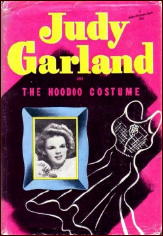
In this age of the celebrity, we think we have seen everything, but truth is there is nothing new under the celebrity sun when it comes to exploiting fame. Whitman, the people behind the Big Little Book, came up with a series of books for older readers in the 1940‘s, and beyond the usual cowboy stars, and comic strip heroes they carried it one step farther with adventures of Hollywood stars like Shirley Temple, Ginger Rogers, Deanna Durbin, John Payne, and others.
This one features the Ooompf Girl from Denton, Texas, red-haired Ann Sheridan, who visits her friend Tess Whitehouse at her new beauty salon and soon finds herself up to her pretty neck in a mystery involving a mysterious Egyptian Sphinx cult:
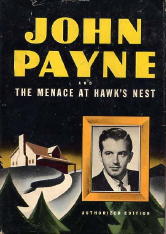
Without knowing it, Ann’s hand that held the key came up to her mouth. She felt her heart mounting in her throat, almost exploding with her terror. She heard a strange, strangled cry and knew it was her own voice.
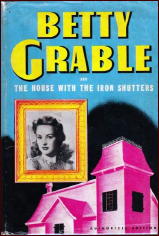
Of course Ann solves the mystery with help of an attractive young man named Crunch, without the slightest hint of romance, but well within the B movie mystery formula the book falls into.
The best part of the book are the attractive illustrations by Henry Vallely, the king of the Big Little Book illustrators whose work graced the adventures of the Lone Ranger, Tom Mix, the Green Hornet, and the Big Little Books own superhero, Maximo. His illustrations are outstanding examples of the art, more than can be said of the story.

Other adventures in this series include Betty Grable and The House With The Iron Shutters, John Payne and the Menace at Hawk’s Nest, Jane Withers and the Phantom Violin, Judy Garland and the Hoodoo Costume, Ann Rutherford and the Key to Nightmare Hall, Ginger Rogers and the Riddle of the Scarlet Cloak, and Deanna Durbin and the Feather of Flame.
It may strike you almost all of these titles fall into the mystery genre in one way or another. If most are like this they are simple low level reads for slightly older children — eight and up — along the line of Nancy Drew or the Hardy Boys or the Rover Boys and Frank Merriwell before them.
There is a little mystery, a few minor scares, and a bit of action. I grant this one is more collectable than readable, but its worth the effort if only for the handsome Vallely illustrations.
Looking at Harry Potter, Anthony Horowitz’s Alex Rider, and the Hunger Games we can at least note how young adult literature has improved. We can consider ourselves lucky we don’t have to deal with Justin Beiber and the Jailer’s Daughter or Myley Cyrus and the Obscene Gesture.
Sat 26 Dec 2015
FIND THE LADY. Major Pictures/J. Arthur Rank, UK, 1956. Donald Houston, Beverley Brooks, Mervyn Johns, Kay Callard, Maurice Kaufmann, Edwin Richfield, Moray Watson, Ferdy Mayne, Anne Heywood. Director: Charles Saunders.
I’ve categorized this old obscure British movie as a crime film, but in all honesty, it’s played a lot more for comedy than it is for thrills. To summarize quickly, though: when the starring lady (Beverley Brooks, as a fashion model from London) goes to spend New Year’s Eve with her godmother out in the country, she finds that the old lady has disappeared.
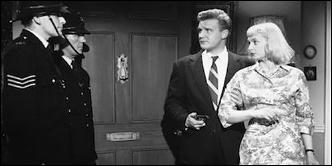
But before that she has a funny (and perhaps at the time hilarious) encounter with the local doctor (Donald Houston) when their paths cross while their automobiles traverse a watersplash (a shallow ford in a stream) in opposite directions. The end result is the doctor falling face first into the water while the young lady’s car stalls and she has to walk into the local village for help.
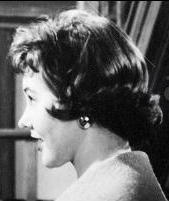
When the missing woman’s brother-in-law (Mervyn Johns) answers the door, getting back to the kidnapping, for that is what it is from the get-go, he says that she has been taken to a nursing home for seclusion and rest. We, of course, know that something is wrong right away. The old woman’s cane is there, her dog is there, and the replacement “maid” (Kay Callard) looks more like a gangster’s moll than I imagine that any gangster’s moll in the real world ever did. (She’s the one on the far right in the photo above.)
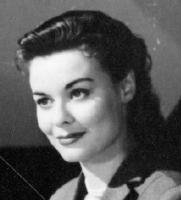
The young woman and the doctor hit it off very well, and they decide to investigate together. Complicating matters is Miss June Weston’s other suitor (Moray Watson) who comes down from London to add some comedy relief to the proceedings.
Most of the names I have dropping are totally new to me. I’d have thought, though, that Beverley Brooks (the beautiful brunette above and up at the top crowded into the phone booth with the doctor) would have had a longer career, but she didn’t. This movie, perhaps her only starring role, was the last one of her career.
But you may noticed Anne Heywood’s name in the credits. She plays the receptionist at the inn (see the photo above) in this, only her second film. She’s very easy on the eyes as well.
Wed 23 Dec 2015
JOHN FARR – The Deadly Combo. Ace Double D-301, paperback original, 1958. Bound back-to-back with Murder Isn’t Funny, by J. Harvey Bond.
Two factors militate against this novel for me: I am not all that fond of the hard-boiled mystery and listening to jazz I find painful. Despite my biases, I must conclude that John Farr, a pseudonym of Jack Webb, has written a dandy novel.
Mac Stewart. whose position on the Los Angeles police force I don’t quite understand — he’s a plainclothes detective who cruises just like a patrolman — has been a jazz enthusiast since he used to sit in alleys listening to tin pan in a noisy speakeasy. Stewart’s love for the music drew him to Dandy Mullens, a former jazz great, from whom he learned a great deal. When Mullens is found stabbed to death in another alley, Stewart investigates on his own.
As I said, this is a hard-boiled novel, but Farr often approaches poetry in his writing. particularly when he is dealing with jazz. It’s somewhat fair play, also, though Stewart is helped by the murderer — at least the first one — being not too bright.
Bibliographic Notes: First of all, the Jack Webb who wrote this book is not the radio-TV-movie actor Jack Webb. There was a lot of confusion about this in the early days of mystery fiction fandom (and elsewhere I’m sure). The Jack Webb who wrote this book was the author of eleven mystery novels under his own name, nine of them with the unlikely sleuthing pair of Father Joseph Shanley and Sammy Golden.
As John Farr, Webb wrote five more crime and detective novels, two of them with a series character named Cy Clements, about whom I know nothing. The Deadly Combo was Mac Stewart’s only appearance.